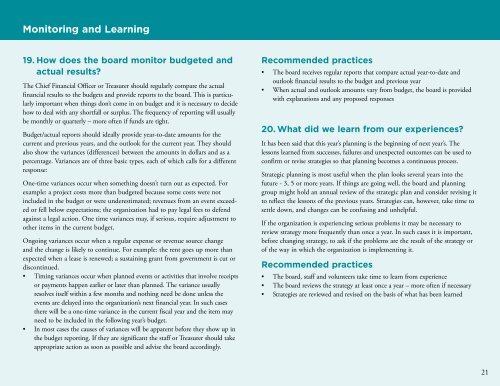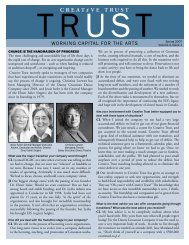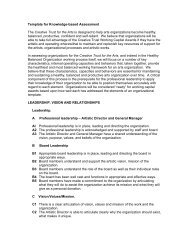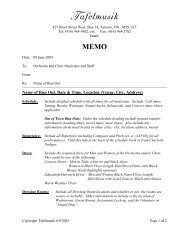20 Questions - Canadian Institute of Chartered Accountants
20 Questions - Canadian Institute of Chartered Accountants
20 Questions - Canadian Institute of Chartered Accountants
You also want an ePaper? Increase the reach of your titles
YUMPU automatically turns print PDFs into web optimized ePapers that Google loves.
Monitoring and Learning<br />
19. How does the board monitor budgeted and<br />
actual results?<br />
The Chief Financial Officer or Treasurer should regularly compare the actual<br />
financial results to the budgets and provide reports to the board. This is particularly<br />
important when things don’t come in on budget and it is necessary to decide<br />
how to deal with any shortfall or surplus. The frequency <strong>of</strong> reporting will usually<br />
be monthly or quarterly – more <strong>of</strong>ten if funds are tight.<br />
Budget/actual reports should ideally provide year-to-date amounts for the<br />
current and previous years, and the outlook for the current year. They should<br />
also show the variances (differences) between the amounts in dollars and as a<br />
percentage. Variances are <strong>of</strong> three basic types, each <strong>of</strong> which calls for a different<br />
response:<br />
One-time variances occur when something doesn’t turn out as expected. For<br />
example: a project costs more than budgeted because some costs were not<br />
included in the budget or were underestimated; revenues from an event exceeded<br />
or fell below expectations; the organization had to pay legal fees to defend<br />
against a legal action. One time variances may, if serious, require adjustment to<br />
other items in the current budget.<br />
Ongoing variances occur when a regular expense or revenue source change<br />
and the change is likely to continue. For example: the rent goes up more than<br />
expected when a lease is renewed; a sustaining grant from government is cut or<br />
discontinued.<br />
• Timing variances occur when planned events or activities that involve receipts<br />
or payments happen earlier or later than planned. The variance usually<br />
resolves itself within a few months and nothing need be done unless the<br />
events are delayed into the organization’s next financial year. In such cases<br />
there will be a one-time variance in the current fiscal year and the item may<br />
need to be included in the following year’s budget.<br />
• In most cases the causes <strong>of</strong> variances will be apparent before they show up in<br />
the budget reporting. If they are significant the staff or Treasurer should take<br />
appropriate action as soon as possible and advise the board accordingly.<br />
Recommended practices<br />
• The board receives regular reports that compare actual year-to-date and<br />
outlook financial results to the budget and previous year<br />
• When actual and outlook amounts vary from budget, the board is provided<br />
with explanations and any proposed responses<br />
<strong>20</strong>. What did we learn from our experiences?<br />
It has been said that this year’s planning is the beginning <strong>of</strong> next year’s. The<br />
lessons learned from successes, failures and unexpected outcomes can be used to<br />
confirm or revise strategies so that planning becomes a continuous process.<br />
Strategic planning is most useful when the plan looks several years into the<br />
future - 3, 5 or more years. If things are going well, the board and planning<br />
group might hold an annual review <strong>of</strong> the strategic plan and consider revising it<br />
to reflect the lessons <strong>of</strong> the previous years. Strategies can, however, take time to<br />
settle down, and changes can be confusing and unhelpful.<br />
If the organization is experiencing serious problems it may be necessary to<br />
review strategy more frequently than once a year. In such cases it is important,<br />
before changing strategy, to ask if the problems are the result <strong>of</strong> the strategy or<br />
<strong>of</strong> the way in which the organization is implementing it.<br />
Recommended practices<br />
• The board, staff and volunteers take time to learn from experience<br />
• The board reviews the strategy at least once a year – more <strong>of</strong>ten if necessary<br />
• Strategies are reviewed and revised on the basis <strong>of</strong> what has been learned<br />
21












